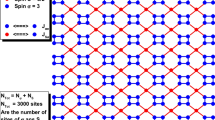Summary
The classical two-dimensionalXY-model is studied at low temperatures within the framework of a variational method which provides some microscopic understanding of the role played by symmetry and dimensionality in static and dynamic properties of magnetic substances. Several types of anisotropy are considered. The main results are:a) A long-range order cannot appear in two dimensions if there is no source of anisotropy in spin space (Mermin-Wagner theorem); this restriction disappears in three dimensions; in any case a phase transition is possible, detectable at least in the thermal behaviour of susceptibility.b) A gap (for vanishing wave vector) in the magnon spectrum can appear in two or three dimensions only if the system is anisotropic in spin space.c) Except for the behaviour in the presence of an external magnetic field. the ferro- and antiferromagnetic cases are equivalent.d) When several spin families are simultaneously present and if the system has not high symmetry, then the static configuration and thenature and the spectrum of elementary excitations depend on temperature and on magnetic field.e) It is possible to understand the experimental fact that, even for very weak anisotropies, the transition temperature remains of the same order of magnitude of the exchange integral.
Résumé
Le modèleXY bidimensionnel classique est étudié à basses températures, dans le cadre d'une méthode variationnelle qui permet de comprendre microscopiquement le rôle joué par la symetrie et la dimension dans les propriétés statiques et dynamiques des substances magnétiques. Plusieurs types d'anisotropies sont considerées. Les principaux résultats sont:a) L'ordre à longue distance ne peut pas apparaître à deux dimensions s'il n'y a pas une source d'anisotropie dans l'espace des spins (théoreme de Mermin-Wagner); cette restriction disparaît à trois dimensions; dans tous les cas une transition de phase est possible, détectable an moins dans le comportement thermique de la susceptibilité.b) Un «gap» (pour vecteur d'onde nul) dans le spectre de magnons peut apparaître—à deux ou trois dimensions—seulement si le système est anisotrope dans l'espace des spins.c) À l'exception du comportement en présence d'un champ magnétique externe, les cas ferro- et antiferromagnétique sont équivalents.d) Quand plusieurs familles de spins se trouvent simultanément en présence, et si le système n'a pas une haute symetrie, alors la configuration statique et lanature et le spectre des excitations élementaires dependent de la température et du champ magnétique.e) Il est possible de comprendre le fait experimental que, même pour des très faibles anisotropies, la température de transition rest du même ordre de grandeur que l'intégrale d'échange.
Riassunto
Si studia il modello classicoXY bidimensionale a bassa temperatura entro lo schema di un metodo variazionale che fornisce alcune conoscenze microscopiche del ruolo giocato dalla simmetria e dalla dimensionalità nelle proprietà statiche e dinamiche delle sostanze magnetiche. Si considerano numerosi tipi di anisotropia. I risultati principali sono:a) L'ordine a lungo raggio non può apparire in due dimensioni se non c'è sorgente di anisotropia nello spazio dello spin (teorema di Mermin-Wagner); questa restrizione sparisce in tre dimensioni; in ogni caso è possibile una transizione di fase, rivelabile almeno nel comportamento termico della suscettività.b) Una fessura (per vettore d'onda tendente a zero) nello spettro dei magnoni può apparire in due o tre dimensioni solo se il sistema è anisotropico nello spazio dello spin.c) Con l'eccezione del comportamento in presenza di un campo magnetico esterno, i casi ferro e antiferromagnetico sono equivalenti.d) Quando numerose famiglie di spin sono presenti simultaneamente e se il sistema non ha una simmetria alta, allora la configurazione statica e lanatura e lo spettro dell'eccitazioni elementari dipendono dalla temperatura e dal campo magnetico.e) È possibile comprendere il fatto sperimentale che, anche per anisotropie molto deboli, la temperatura di transizione rimane dello stesso ordine di grandezza dell'integrale di scambio.
Резюме
Исследуется классическая двумернаяXY модель при низких температурах, в рамках вариационного метода, который обеспечивает микроскопическое понимание роли, которую играют симметрия и размерность в статических и динамических свойствах магнитных веществ. Рассматриваются несколько типов анизотропии. Основные результаты представляют:а) В случае двух измерений дальний порядок не может возникнуть, если не существует источника анизотропии в спиновом пространстве (теорема Мермина-Вагнера). Это ограничение исчезает в случае трех измерений; в любом случае фазовый переход может быть зарегистрирован, по крайней мере, в тепловом поведении магнитной восприимчивости.б) Щель (для нулевого волного вектора) в спектре магнонов может возникать в случае двух или трех измерений только, если система является анизотропной в спиновом пространстве.в) Ферро- и антиферромагнитные случаи являются эквивалентными, за исключением поведения при наличии внешнего магнитного поля.г) Когда одновременно присутствуют несколько спиновых семейств и если система не обладает высокой симметрией, то статическая конфигурация имип и спектр элементарных возбуждений зависят от температуры и магнитного поля.д) Можно объяснить экспериментальный факт, что, даже для очень слабых анизотропий, температура перехода остается того же порядка величины обменного интеграла.
Similar content being viewed by others
References
N. D. Mermin andH. Wagner:Phys. Rev. Lett.,17, 1133 (1966).
H. E. Stanley andT. A. Kaplan:Phys. Rev. Lett.,17, 913 (1966).
R. Plumier:J. Physique,24, 741 (1963).
D. W. Hone:Ann. Rev. Mat. Sci. (preprint).
V. L. Berezinskii:Žurn. Ėksp. Teor. Fiz.,59, 907 (1970) (English translation:Sov. Phys. JETP,32, 493 (1971)).
V. L. Berezinskii:Žurn. Ėksp. Teor. Fiz.,61, 1144 (1971) (English translation:Sov. Phys. JETP,34, 610 (1972)).
G. Sarma:Solid State Comm.,10, 1049 (1972).
J. Villain:J. Physique,35, 27 (1974).
H. J. Mikeska: preprint.
J. Villain:J. Phys. C,6, L 97 (1973).
A. Herpin:Théorie du magnétisme, Chapt. V (Paris, 1968).
K. Hirakawa, I. Yamada andY. Kurogi:J. Physique 32, C 1 890 (1971).
V. J. Minkiewicz, D. E. Cox andG. Shirane:J. Physique,32, C 1 892 (1971).
J. Skalyo jr.,G. Shirane andR. J. Birgeneau:J. Physique,32, C 1 882 (1971).
R. J. Birgeneau, J. Skalyo jr. andG. Shirane:Phys. Rev. B,3, 1736 (1971).
R. J. Birgeneau, H. J. Guggenheim andG. Shirane:Phys. Rev. B,1, 2211 (1970).
Author information
Authors and Affiliations
Additional information
Traduzione a cura della Redazione.
Переведено редакцией.
This work was partially supported by BNDE and CNPq, Brazil.
Rights and permissions
About this article
Cite this article
Tsallis, C. Classical statistical approach to anisotropic two-dimensionalXY-model. Nuov Cim B 34, 411–435 (1976). https://doi.org/10.1007/BF02728617
Received:
Revised:
Published:
Issue Date:
DOI: https://doi.org/10.1007/BF02728617




